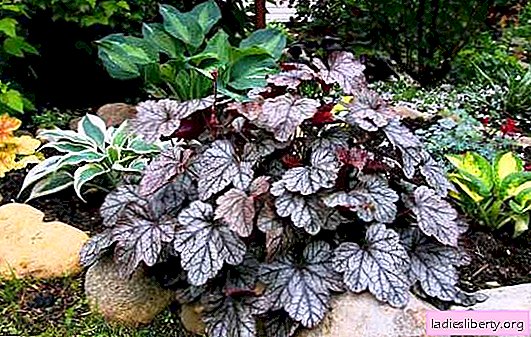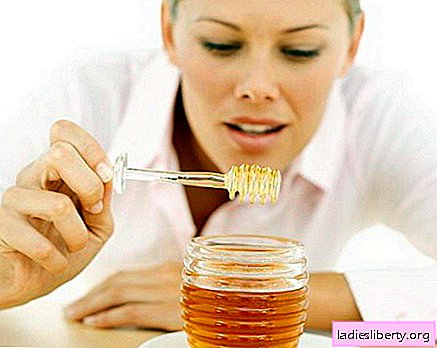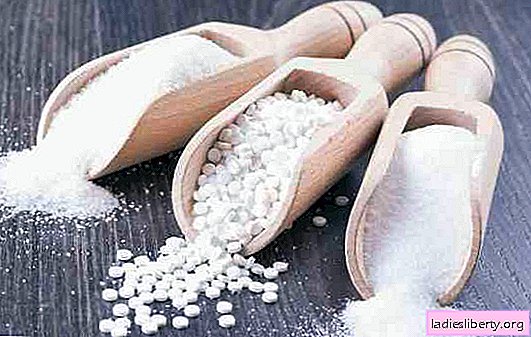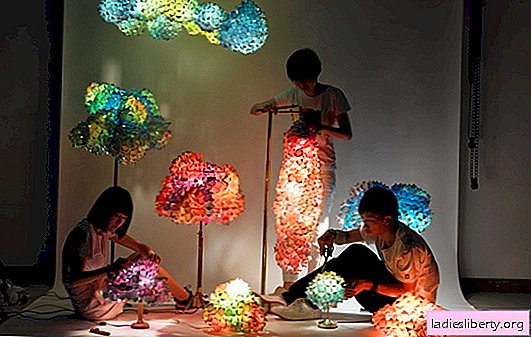
Geichera is a rhizome perennial that attracts with its appearance.
The color of the leaves of the plant changes throughout the growing season.
Shrub occupies a well-deserved place among plants and is often used in landscape design.
Description and characteristics of heichera
Geichera is a herbaceous shrub of the Kamnelomkov family. In the natural environment, the plant can be found in North America. Heicher leaves are very decorative, leathery and dense. Thanks to them, the flower does not lose attractiveness throughout the season. The shape and color of the leaves is quite diverse, there are plants with black, red, scarlet, yellow, purple and patterned leaves. Particularly valuable specimens are distinguished by the presence of specks and all kinds of stains on the surface of the sheet. The texture of the sheet plate is rather unusual: curly, smooth and corrugated.
The plant blooms in small flowers resembling bells. Their color is pink, white or cream. The duration of flowering depends on the variety. Often the plant blooms until the frost. At the end of flowering, a fruit with small seeds is formed in place of the bluebells.
In landscape design, decorative-leafy specimens of heichera are used, which are planted on flower beds or along the main ones more expensive than the garden.
Varieties and varieties of heichera with photos
The genus of heichera has many varieties that can only be found in natural habitats. In gardening and design, only a few are common.
Blood Red Heichera

This plant belongs to the mountain species of hehera. The color of the leaves is green, the flowers are bright red. Pouring this variety form a dense outlet. Especially valuable varieties with white and cream interspersed on a leaf plate. During flowering, the plant releases a panicle, the length of which is up to 50 cm. The winter hardiness of the variety is good.
Geichera small flowered

One of the most ornamental plants. The leaves resemble maple leaves in shape, and bright silver stains give them a special decorative effect. Peduncles are high, up to 60 cm. The color of the flowers is cream.
Hybrid heicher

These plants include all interspecific hybrids that are obtained by crossing. Their leaves and flowers are much larger than that of their parent plants. The color of the flowers ranges from white to red. The leaves are green in color with various dots. The disadvantage of hybrid heicher is their low frost resistance and fragility of peduncles, which are easily damaged by gusts of wind.
Growing heichera in the garden: planting and everything connected with it (photo)
In the garden, heichera is planted in groups or in combination with other crops. The plant looks good in the company of astilbe, cereals, daylilies and primroses.
Where to plant a heicher?
Heichera cultivation begins by choosing a location for the plant. The flower tolerates shade well, so the eastern or western side of the garden is the best place for it, where the lighting will be less intense. Experienced gardeners recommend planting a heichera under the shadow of other plants. However, varieties with a bright color of the leaves should be located in well-lit areas, where they acquire more saturated shades. Geichera with red leaves is grown only in the sun, in shady places the color of the leaves remains green.
Soil preparation for heichera planting
Geichera belongs to unpretentious perennials, grows equally well on any soil, but does not tolerate acidic soils. When planting heichera, you need to pay attention to the fertility and friability of the earth. In such a substrate, the plant develops especially well. Sand and peat are added to heavy clay soils.
Important! It should be remembered that the soil for planting must be drained. The plant does not tolerate stagnation of water near the root system, which leads to death.
How and when to plant a heicher?
Landing begins in the spring, in March - April. For planting, seeds or prepared heicher seedlings are used.
Sowing seeds is carried out in the treated soil. Shoots appear fast enough. But seed propagation of heichera is less popular, since the resulting plants do not retain all varietal traits. Of the collected seeds, ordinary shrubs with green leaves most often grow.
Often, heichera is planted with seedlings, dividers obtained by dividing the mother bush. As a rule, the plant retains its decorative effect for no more than three years, after which it must be planted. The mother plant is dug up and divided into parts. Each piece must have its own roots. After planting the seedlings in a permanent place, they are abundantly watered and shaded.

Care for geyhera in the garden: watering, feeding, preparation for wintering
Growing perennials is easy. It is enough to observe the main points for the care of a hehera.
Supplementary food
In the year of planting under the plant do not make any fertilizer. In subsequent years of cultivation, perennials are fed with complex fertilizers for decorative and deciduous plants. The first feeding is carried out at the beginning of the growing season, the following - before the flowering and after it. The last feeding is carried out with a solution with a lower concentration of nutrients, which ensures a good wintering of the hehera.
Watering
Heichera refers to plants that can withstand drought. Excess moisture is contraindicated for them. Watering is carried out as the soil dries, not more than 1 time in 3 days. In hot summers, you can increase the frequency of watering. It is recommended to water the heicher in the evening. When watering in the morning, the water remaining on the leaves leads to burns.
When caring for a heicher, one should not forget about mulching the soil. This will reduce the frequency of weeding and provide the plant with additional nutrition.
Heicher care after flowering
Flowering of some types of heichera lasts more than two months. After it ends, flower boxes form seeds with stems, which spoils the decorativeness of the plant. Therefore, after the flowers fall, the flower stalks are cut.
How to prepare a plant for winter
Geicher hibernates in open ground. For a successful wintering, the plant needs heat in the root zone. In autumn, you can not cut the yellowed leaves of the perennial, it is they that retain the necessary heat. In some areas, without a shelter, a heicher does not tolerate harsh winters. As the mulching material, oak leaves are used. In early spring, it is necessary to free the perennial from the covering material and trim old leaves. Pruning is carried out close to the ground.
Heichera disease and pest control
With proper care, the plant is not afraid of pests and rarely gets sick. The cause of frequent diseases is a decrease in perennial immunity, excessive watering and abuse of fertilizers.
Most often, heichera has the following diseases:
• powdery mildew;
• rust;
• spotting;
• gray rot.
When white plaque appears on the leaves, heichera treatment with fungicides. They fight rust and spotting with Bordeaux fluid.
In a rainy summer, a heicher suffers from snails, slugs and caterpillars. They are destroyed by insecticides.











